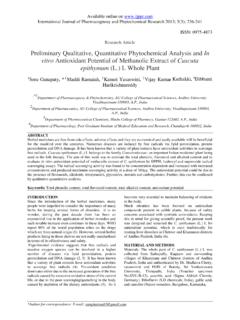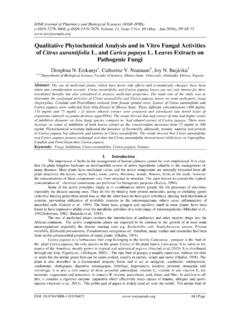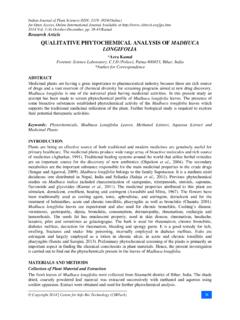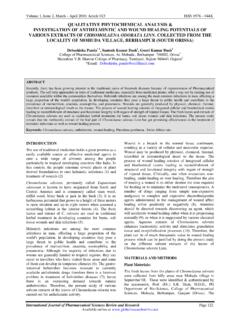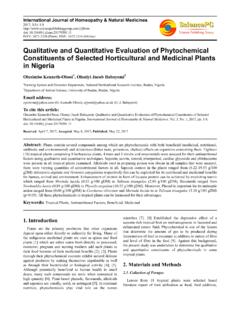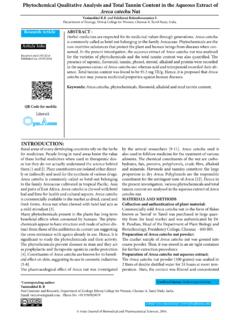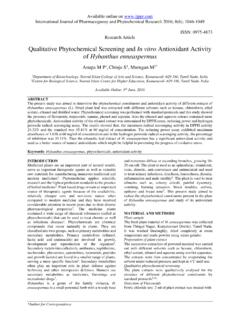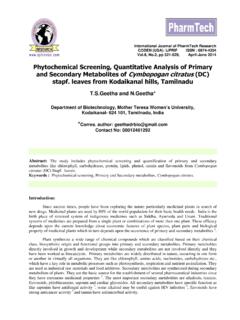Transcription of Comparative Qualitative Phytochemical analysis of the ...
1 52. Journal of Pharmaceutical, Chemical and Biological Sciences ISSN: 2348-7658. CODEN: JPCBBG. June - August 2018 ; 6(2):52-59. Online available at The work is licensed under Research Article Comparative Qualitative Phytochemical analysis of the different parts of Barleria dinteri (Oberm): A contribution to sustainable use of the plant species C. J. SEMENYA1, R. B. MASEKO1, S. S. GOLOLO2*. 1 Department of Chemistry, School of Science and Technology, Sefako Makgatho Health Sciences University, Ga-Rankuwa 0204, Pretoria, South Africa 2 Department of Biochemistry, School of Science and Technology, Sefako Makgatho Health Sciences University, Ga-Rankuwa 0204, Pretoria, South Africa *CORRESPONDING AUTHOR ARTICLE INFORMATION. S. S. GOLOLO, Department of Biochemistry, School of Science Received March 23 , 2018. and Technology, Sefako Makgatho Health Sciences University, Revised April 16, 2018.
2 Ga-Rankuwa 0204, Pretoria, South Africa Accepted April 26, 2018. E-mail: Published June 28, 2018. ABSTRACT. The objective of the study was to undertake a Comparative Qualitative Phytochemical analysis of the different parts of Barleria dinteri, a traditional herb used against several diseases. The different parts of B. dinteri were extracted using cold maceration method through a serial exhaustive exclusion procedure. The extracts were subjected to Qualitative Phytochemical analysis through chemical screening, thin layer chromatography and UV-visible spectrophotometric analysis . Qualitative Phytochemical analysis through chemical screening showed mostly similarities in the Phytochemical compositions of the different plant parts with only few differences observed. Anthraquinones were not detected in the extracts of all different plant parts. The TLC profiles of samples, depicted through the Rf values of resolved compound bands, also showed mostly similarities with few differences.
3 The UV- visible spectrum of the samples showed mostly similar maximum absorbance wavelengths amongst similar extracts of the different plant parts. From the results of this study it can be concluded that the Qualitative Phytochemical profiles of branches, flowers, leaves and roots of B. dinteri are more similar. As such, the aerial parts of B. dinteri could be recommended to substitute the usage of the roots in traditional medicine as a contribution to sustainable usage of the plant species. KEYWORDS: Barleria dinteri; phytochemicals; plant parts; chemical screening tests; thin layer chromatography; UV-vis spectrophotometry. INTRODUCTION. Plants possess a unique richness and diversity of Medicinal plants contain naturally-occurring metabolites [1]. Natural products isolated from phytochemicals that have defence mechanisms plants have been postulated to remain an and protection from various diseases [3].
4 Most essential part of the search for novel medicines phytochemicals have been known to bear against human diseases. Although the plant valuable therapeutic activities such as kingdom has remained poorly explored, today insecticidal, antibacterial, antifungal, anti- there is growing interest in chemical constipative, spasmolytic, anti-plasmodial and composition of plant based medicines [2]. antioxidation [4, 5, 6]. Majority of the population J Pharm Chem Biol Sci, June-August 2018; 6(2):52-59. 53. in developing countries depends on traditional for treatment of diseases such as intestinal medicine for their primary health care [7]. tumours and bacterial infections. It is found in Population growth, urbanization and specific areas in three provinces of South Africa, unrestricted collection of medicinal plants from namely, Limpopo, Mpumalanga and Gauteng.
5 The wild are resulting in an over-exploitation of Swaziland, Botswana and Namibia. B. dinteri is natural resources in Southern Africa [8]. one medicinal plant whose roots and leaves are Collection of underground parts, the roots, of used interchangeably in traditional medicine medicinal plants leads to mass scale uprooting of (healing) in Limpopo province, South Africa [16]. plants from their natural habitat [9]. This may In this regard, the primary aim of the study was lead to depletion of plant resources in the near to undertake the Qualitative Phytochemical future due to which, unavailability of plants for analysis of different parts (namely, flowers, use in traditional system of medicine may arise. leaves, branches and roots) of Barleria dinteri While some of the species may have certain with intention of motivation for usage of plant traits that enable them to recover quickly and parts with less adverse implications for the are able to adapt to continuous harvesting, survival of the plant species.
6 Others exhibit traits that make them very sensitive to uncontrolled harvesting and these MATERIALS AND METHODS. species may not recover for a long time [10]. Chemicals Conservation of medicinal plants has become a All chemicals, reagent and solvent used during subject of primary importance considering a the experimentation were of analytical grade constant expansion of the rare or endangered and TLC plates were purchased from Merck plant species list [11]. Substitution of the under (Pty) Ltd, (Halfway House, South Africa). surfaced plant parts with aerial parts may contribute to the prevention of the rapid Collection and Identification of the plant addition of more medicinal plants on the plant material red list [12, 13]. However, plant parts The flowers, leaves, branches and roots of B. substitution may only be pursued provided the dinteri (Voucher specimen: UNIN 11118) were substituting part possess similar or more collected from Zebediela in Limpopo Province, beneficial properties, which may be assessed in South Africa during the full bloom season, using terms of the Comparative Phytochemical convenient sampling method.
7 The different plant composition. parts were dried at room temperature, ground to Comparison of the Phytochemical composition of powder and stored in the dark until used. different plant parts may lead to the utilization of plants parts, in particular the aerial parts, Extraction with minimum adversity to the conservation of The ground branches, flowers, leaves and roots the plants. In a study by Srivastava et al [14], (5 g) of B. dinteri collected from Zebediela in the major bioactive constituents of the different Limpopo Province, South Africa were each parts (roots, stem and flowers) of Taraxacum extracted with 50 ml of n-hexane, officinale were analysed for comparison. dichloromethane, acetone and methanol using Saponins, flavonoids, alkaloids, phenols were cold maceration method in a serial exhaustive highly concentrated in the stems, roots and extraction procedure.
8 The resultant extracts flowers, with higher concentration of flavonoids were filtered and the solvents evaporated under in the flower extract. In another separate study, a stream of air. the Phytochemical composition of the root and leaf parts of the medicinal herb, Hypochaeris Experimental procedure radicata L. were also investigated [15]. The Phytochemical screening using chemical findings of the study showed that alkaloids, reactions cardiac glycosides, phenols, resins, saponins, Chemical screening tests for the detection of steroids, tannins, terpenoids and triterpenoids bioactive chemical constituents in extracts of the were found in both the leaf and root extracts. different parts of B. dinteri were carried out Barleria dinteri is a rare medicinal plant with using the standard procedures described below specific habitation that belongs to the family [17]: Acanthaceae and used in traditional medicine Test for Alkaloids- Hager's test J Pharm Chem Biol Sci, June-August 2018 ; 6(2):52-59.
9 54. To 1 ml of the sample, few drops of Hager's acetate (9:1 v/v) for low polarity; Chloroform: reagent (Picric acid) was added. Formation of a Methanol (9:1 v/v) for intermediate polarity, and yellow precipitate indicates the presence of Ethyl acetate: Methanol: Water (8:4:1 v/v/v) for alkaloids. high polarity. Compound bands within extracts Test for Anthraquinones were located and circled on TLC plates upon eye A small fraction of the sample was mixed with visualization, under UV light, as well as after 10 ml chloroform; the mixture was shaken and spraying with vanillin in sulphuric acid. The filtered. Thereafter, 5 ml of 10 % NH3 solution retention factors (Rf) of the resolved compound was added to the filtrate. The appearance of bands were calculated as follows: pink/red colour confirms the presence of anthraquinones. Test for Coumarins Few drops of 10 % NaOH was added to the extract, after which chloroform was added.
10 Ultraviolet- visible spectrophotometric Observation of yellow colour which shows the analysis presence of coumarins. The extracts of the different parts of B. dinteri Tests for Flavonoids - (Shinoda test- were subjected to UV-vis spectrophotometric Magnesium hydrochloride reduction test) analysis [18]. Each sample of the plant parts To the test solution, few fragments of extracts was diluted ten-fold and scanned along magnesium ribbon and concentrated the wavelength range of 200-750 nm using a hydrochloric acid were added drop wise. CECIL 1021 spectrophotometer (LASEC, ). Observation of reddish to pink colour indicates Wavelengths of peaks showing maximum the presence of flavonoids. absorbance were then noted and recorded. Test for Tannins A 2ml amount of distilled water was added to 1 RESULTS. ml extract solution and then few drops of ferric Extracts of the different parts, namely: chloride solution were added.


